|
|
|
Sort Order |
|
|
|
Items / Page
|
|
|
|
|
|
|
| Srl | Item |
| 1 |
ID:
179283
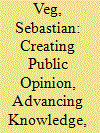

|
|
|
|
|
| Summary/Abstract |
Situated far from coastal cities and foreign concessions, Chengdu yields insights into the role of the local press and its specific publics in the political evolution of the late Qing and early Republic. Despite its remote location, Chengdu developed its own modern press in the late Qing, relying on print entrepreneurs and modern journalists recruited from the ranks of the local literati and traditional sociability, in particular teahouses. They all played a role in forming a modern reading public which came to understand itself as a distinct local political community in dynamic interaction with national politics and transnational networks. The local press evinced three successive but intertwined ideals of publicness: as a link between the state and the people and a vector of enlightenment, as a professional forum for public opinion and as a tool for political mobilization. In solidifying public opinion around the local community, the press served as a forum and catalyst for political activism in the 1911 Railroad Protection movement and the 1919 May Fourth movement, events which were shaped as much by local dynamics as they were by national developments.
|
|
|
|
|
|
|
|
|
|
|
|
|
|
|
|
| 2 |
ID:
091964
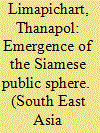

|
|
|
|
|
| Publication |
2009.
|
| Summary/Abstract |
The Siamese public sphere emerged in the second half of the nineteenth century from a series of historical events - the advent of print technology, the signing of new trade treaties and the agreements on extraterritoriality between Siam and several colonial powers, beginning with the British in 1855. This critical development generated a drastic transformation in Siam's mode of textual production, dissemination and consumption. Newspapers, journals and printed books were produced for the first time, and with them came new kinds of knowledge, forms of entertainment and spaces for discursive contestation. These changes inevitably challenged the Siamese ruling elite's ability to control political discourse and literary production, along with their essential cultural authority. Since these new spaces and practices could not be prohibited or closed down by traditional means of law and order such as the exercise of raw power, the Siamese elite responded to the challenges by resorting to various strategies: proclamations, financial subsidies to and buyouts of critical newspapers, the enactment of press laws and participating in the public sphere themselves. Members of the elite thus came to play the role of publishers as well as of political and literary critics. In this respect they became, however influential, only one discursive force among others in the new space.
|
|
|
|
|
|
|
|
|
|
|
|
|
|
|
|
| 3 |
ID:
175488
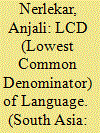

|
|
|
|
|
| Summary/Abstract |
The tumultuous politics of the post-Independence period in Bombay/Mumbai, and the creation of the linguistic states, released multiple and contradictory energies towards a re-examination of the Marathi language and its valence in linguistic, literary, social and cultural contexts. This essay employs the bilingual poetry of Arun Kolatkar and the Marathi-language poetry of R.K. Joshi to show the ways in which the sathottari poetry of Bombay engages with these socio-political questions of language and region by channelling the principles of concrete poetry and making the visual presence of the language (in its script, its lines, its presence on the page) a part of its meaning-making process.
|
|
|
|
|
|
|
|
|
|
|
|
|
|
|
|
| 4 |
ID:
157870
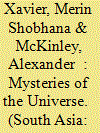

|
|
|
|
|
| Summary/Abstract |
This article analyses M.C. Siddi Lebbe's (d. 1898) Sufi treatise, Asrarul Alam (Mysteries of the Universe), with attention to the literary networks operating among late nineteenth-century South Asian Muslims. The diversity of Lebbe's source material and complexity of his argumentation signal his broad engagement with Islamic thought old and new, foreign and local, Arabic and Tamil. Furthermore, Lebbe cast his literary network especially wide, incorporating non-Islamic ideas like theosophy and yoga from Euro-American and Indic sources as foils for the explication of Sufism. This philosophical mosaic in turn sparked debate among Muslim scholars. Asrarul Alam became an impetus for identity definition in a controversy that involved high stakes in translation choices and the unique complexities of works by a trilingual author such as Lebbe.
|
|
|
|
|
|
|
|
|
|
|
|
|
|
|
|
| 5 |
ID:
152354
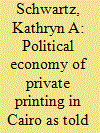

|
|
|
|
|
| Summary/Abstract |
This article examines the political economy of Cairo's emerging Arabic private printing industry during the third quarter of the 19th century. I use the constituent texts of the industry to demonstrate that it developed upon the speculative model of commissioning, whereby individuals paid printers to produce particular works of their choosing. Commissioning indicates that Egyptian private printing grew from local traditions for producing handwritten texts. Nevertheless, print commissioning differed from manuscript commissioning by requiring individuals to assume great financial risk. I explore the nature and implications of this divergence through a treatise published in 1871 by Musa Kastali, a particularly prolific printer who helped to professionalize Cairene printing. Musa's treatise details his legal battle with a famous Azhari commissioner, and is unique for describing a printer's business practices. It demonstrates the importance of situating printings within their socioeconomic contexts in addition to their intellectual ones, a task which cannot be done without an appreciation for the functioning of the printing industry at a local level.
|
|
|
|
|
|
|
|
|
|
|
|
|
|
|
|
| 6 |
ID:
139902
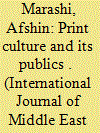

|
|
|
|
|
| Summary/Abstract |
This article investigates the evolution of print culture and commerce in Tehran during the first half of the 20th century. The first section examines technological changes that facilitated the commercialization of texts and then details the history of early print entrepreneurs in the Tehran bazaar. The second section examines the expansion of the book trade between the 1920s and 1940s, tracing the emergence of modern bookstores in a rapidly changing Tehran. I argue that patterns of change in print commerce between 1900 and 1950 contributed to the emergence of mass culture by midcentury. This new mass culture involved the social and political empowerment of a diversity of new reading publics in the city, and enabled the emergence of new forms of popular politics.
|
|
|
|
|
|
|
|
|
|
|
|
|
|
|
|
| 7 |
ID:
174504
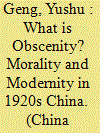

|
|
|
|
|
| Summary/Abstract |
This paper examines the debates over the meaning of obscene (yin 淫) in 1920s China. Although the censorial category yinshu (淫书 obscene books) long existed in imperial China, in the late 1910s and 1920s, commonly known as the May Fourth era, the meaning and content of this genre underwent intriguing changes following Chinese intellectuals’ quest for enlightenment and modernity. As Kendrick Walter has insightfully remarked in his study of pornography in Western modern culture, “Pornography names an argument, not a thing” (1987: 31). The argument over the meaning of yin offers a unique perspective into the complicated relationship between science, morality, and modernity in Republican China.
|
|
|
|
|
|
|
|
|
|
|
|
|
|
|
|
|
|
|
|
|